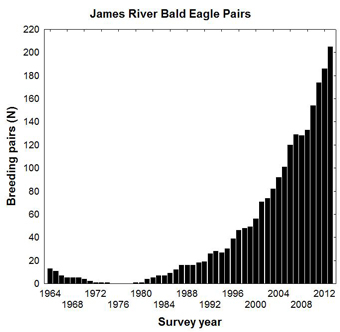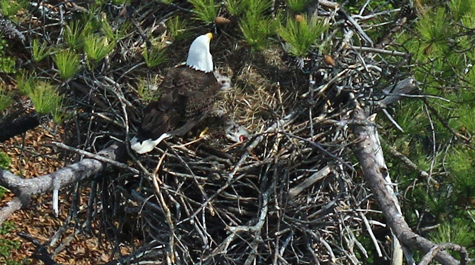The James River: Comeback central for bald eagles
There are more bald eagles than ever nesting along the James River—and it’s likely that the population is getting close to the saturation point.
Results of the 2013 aerial census surveys show that the James River is home to more than 200 pairs of nesting bald eagles. It’s the highest concentration of breeding birds along the James River in recorded history, said Bryan Watts, director of the Center for Conservation Biology. The CCB has conducted eagle census flights in the region since 1977, when it took over an annual survey that goes back more than half a century.
“The James River population represents the best example of bald eagle recovery in the nation,” Watts said. “By the early 1960s the once-thriving population had been reduced to below 15 pairs due to environmental contaminants and by the mid-1970s no pairs remained along the river.”
Watts explained that the tidal James is ideal eagle habitat. The birds nest in large trees, and never far from water and the river offers plenty of food for the fish-eating raptors.
 “Ultimately it comes down to available
energy to support the birds, and the James is a very productive system,” Watts
said.
“Ultimately it comes down to available
energy to support the birds, and the James is a very productive system,” Watts
said.
Watts explained that the eagle recovery began following the banning of DDT and other compounds. A single pair was found on the James in 1980. Recovery was slow in the early years, he said, and as recently as 2000 the river supported only 57 pairs, producing 85 young.
This year’s census showed a total of 205 pairs of eagles, which have produced 267 chicks. Watts says that the James River has one of the densest populations of bald eagles in eastern North America. The most prolific areas (and number of breeding pairs logged) are Charles City County (46), Prince George County (31), James City County (29) and Surry County (28).
“The dramatic recovery reflects the resiliency of both the bald eagle and James River,” Watts said. “This small geographic area now supports more breeding pairs than all surrounding states with the exception of Maryland.”
Watts noted that the James River is probably getting close to the bald eagle saturation point, but said he can’t assess precisely what that point is, but noted he expects a slowdown in growth.
“The river has to be getting close to carrying capacity,” he said. “The population will ultimately tell us; it is doing that.”
He pointed out that through the 90s, the James River eagle population was growing at a maximum rate, in that all the birds produced were assimilated into the area. “Now, the assimilation percentage is down to about 20 percent,” Watts said. “This suggests that the brakes are being applied.”
The Center for Conservation Biology has conducted the aerial eagle surveys since 1977, beginning with Mitchell Byrd, the first director of the CCB. Watts and Byrd received National Recovery Champion awards from the U.S. Fish and Wildlife Service in 2008.
Watts and Byrd still make the census flights each year, in a Cessna 172 operated by a former fighter pilot who prefers to be known as Captain Fuzzzo. (The middle “z” is silent, he says.) This year marks the 37th consecutive year that Byrd has done the surveys and the
The CCB researchers survey the eagles from the air twice each year. The first set of flights takes place between late February and the end of March. The goal of the first round is to map out breeding territories. Individual nests are marked as “occupied” if the researchers see evidence of nest maintenance or if a pair of birds are nearby. Nests that have eagles in incubating posture or reveal presence of chicks or eggs are marked “active.”
A second set of flights, in late April through May, allows Watts and Byrd to check occupied nests for productivity and to recheck occupied territories for breeding.
Watts said that the eagle population growth is greatest along the James, but there also are plenty of eagles throughout the Chesapeake Bay area. The resurgent eagle population is starting to affect other waterbirds and Watts says that the eagles have begun foraging in colonies of gulls, pelicans and great blue herons.
“This story is just beginning and it will be very interesting to see how it plays out,” Watts said. “The Bay now has about 1,600 to 2,000 breeding pairs—that equates to 15,000 to 20,000 individual birds; many of these birds are juveniles. They are foraging all over on whatever they can get, including other waterbirds.”
The Center for Conservation Biology is a joint program of the College of William & Mary and Virginia Commonwealth University.
 Skip to main content
Skip to main content

